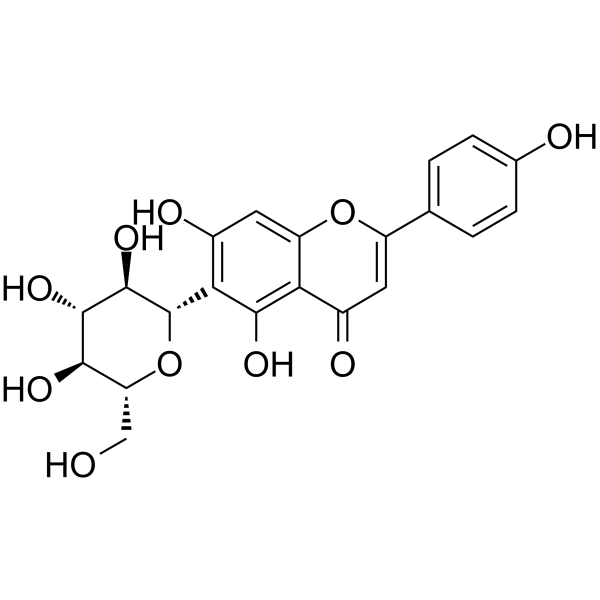天然产物 糖类和糖苷 Saccharides and Glycosides
Isovitexin;(Synonyms: 异牡荆黄素; Saponaretin; Homovitexin) 纯度: 99.95%
Isovitexin 是从亚洲水稻种得到的黄酮类物质,具有抗氧化、抗炎的活性;Isovitexin 作用与 JNK1/2 的抑制剂类似,能够抑制 NF-κB 的活化。

Isovitexin Chemical Structure
CAS No. : 38953-85-4
| 规格 | 价格 | 是否有货 | 数量 |
|---|---|---|---|
| 10;mM;*;1 mL in DMSO | ¥1331 | In-stock | |
| 5 mg | ¥1210 | In-stock | |
| 10 mg | ¥1760 | In-stock | |
| 25 mg | ¥3520 | In-stock | |
| 50 mg | ; | 询价 | ; |
| 100 mg | ; | 询价 | ; |
* Please select Quantity before adding items.
Isovitexin 相关产品
bull;相关化合物库:
- Natural Product Library Plus
- Bioactive Compound Library Plus
- Immunology/Inflammation Compound Library
- Kinase Inhibitor Library
- MAPK Compound Library
- NF-kappa;B Signaling Compound Library
- Stem Cell Signaling Compound Library
- Natural Product Library
- Anti-Aging Compound Library
- Antioxidants Compound Library
- Differentiation Inducing Compound Library
- Reprogramming Compound Library
- Glycoside Compound Library
- Oxygen Sensing Compound Library
- Phenols Library
- Pyroptosis Compound Library
- Traditional Chinese Medicine Monomer Library
- Flavonoids Library
- Anti-Breast Cancer Compound Library
- Anti-Pancreatic Cancer Compound Library
- Anti-Blood Cancer Compound Library
- Anti-Parkinson’s Disease Compound Library
- Anti-Obesity Compound Library
- Transcription Factor Targeted Library
- Food-Sourced Compound Library
- Anti-Liver Cancer Compound Library
| 生物活性 |
Isovitexin is a flavonoid isolated from rice hulls of Oryza sativa, possesses anti-inflammatory and anti-oxidant activities; Isovitexin acts like a JNK1/2 inhibitor and inhibits the activation of NF-κB. |
||||||||||||||||
|---|---|---|---|---|---|---|---|---|---|---|---|---|---|---|---|---|---|
| IC50 Target |
|
||||||||||||||||
| 体外研究 (In Vitro) |
Isovitexin protects against LPS-induced oxidative damage by suppressing intracellular ROS generation, and also attenuates the effect of H2O2 on cell viability. Isovitexin (0-100 μg/mL) with LPS (2 μg/mL) is not cytotoxic to RAW 264.7 cells, but 200 μg/mL Isovitexin shows significant cytotoxicity. Isovitexin (25, 50 μg/mL) inhibits LPS-induced increases in TNF-α, IL-6, iNOS, and COX-2 levels. Isovitexin (25, 50 μg/mL) also suppresses the IκBα phosphorylation and degradation in RAW 264.7 cells, and such an effect is consistent with that of JNK1/2 inhibitor[1]. MCE has not independently confirmed the accuracy of these methods. They are for reference only. |
||||||||||||||||
| 体内研究 (In Vivo) |
Isovitexin (50 and 100 mg/kg, i.p.) causes less severe histopathological changes in the lung sections, and reduces inflammatory cell count in LPS-induced mice. Isovitexin (50 and 100 mg/kg, i.p.) protects against LPS-induced inflammation and oxidative stress in LPS-induced ALI mice by decreasing TNF-α and IL-6 production, ROS generation, and MPO and MDA content, increasing SOD and GSH levels and effectively inhibiting the protein expression of iNOS and COX-2[1]. Isovitexin (25, 50, 100 mg/kg) dose-dependently reduces the survival rate of LPS/D-gal induced hepatic injury in mice. Isovitexin also inhibits NF-κB activation and up-regulates Nrf2 and HO-1 induced by LPS/D-gal in mice[2]. MCE has not independently confirmed the accuracy of these methods. They are for reference only. |
||||||||||||||||
| 分子量 |
432.38 |
||||||||||||||||
| Formula |
C21H20O10 |
||||||||||||||||
| CAS 号 |
38953-85-4 |
||||||||||||||||
| 中文名称 |
异牡荆黄素 |
||||||||||||||||
| 运输条件 |
Room temperature in continental US; may vary elsewhere. |
||||||||||||||||
| 储存方式 |
|
||||||||||||||||
| 溶解性数据 |
In Vitro:;
DMSO : 25 mg/mL (57.82 mM; Need ultrasonic) 配制储备液
*
请根据产品在不同溶剂中的溶解度选择合适的溶剂配制储备液;一旦配成溶液,请分装保存,避免反复冻融造成的产品失效。 In Vivo:
请根据您的实验动物和给药方式选择适当的溶解方案。以下溶解方案都请先按照 In Vitro 方式配制澄清的储备液,再依次添加助溶剂: ——为保证实验结果的可靠性,澄清的储备液可以根据储存条件,适当保存;体内实验的工作液,建议您现用现配,当天使用; 以下溶剂前显示的百
|
||||||||||||||||
| 参考文献 |
|
| Cell Assay [1] |
Cell viability is determined by an MTT assay. RAW 264.7 cells are plated in 96-well plates (1 × 104 cells/well) and incubated with various concentrations of Isovitexin (final concentration: 0-200 μg/mL) and LPS (2 μg/mL) for 24 h. In addition, the cells are pretreated with IV (25 or 50 μg/mL) for 1 h, followed by the addition of H2O2 (300 μM). After 24 h, MTT (5 mg/mL) is added to the cells, which are then incubated for another 4 h[1]. MCE has not independently confirmed the accuracy of these methods. They are for reference only. |
|---|---|
| Animal Administration [1] |
Mice[1] MCE has not independently confirmed the accuracy of these methods. They are for reference only. |
| 参考文献 |
|
